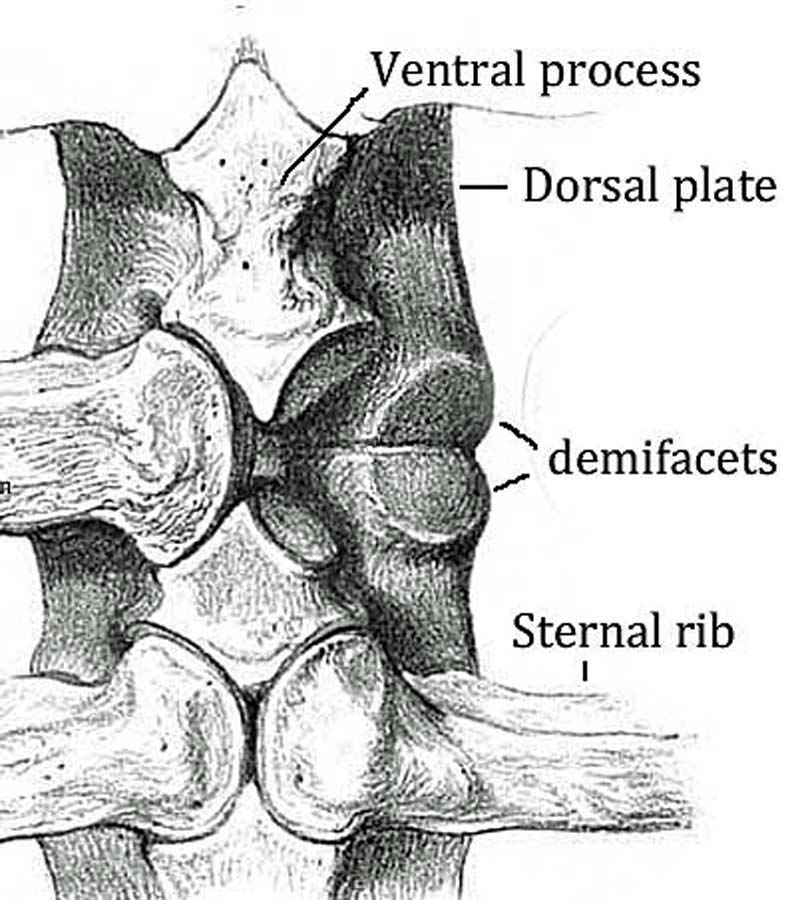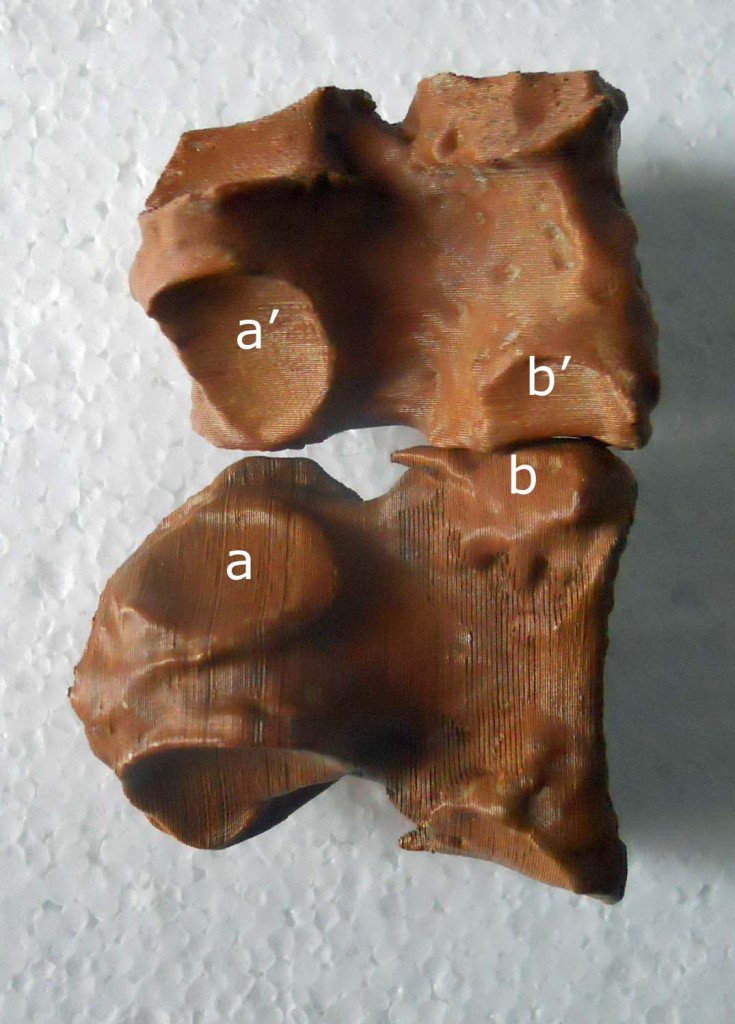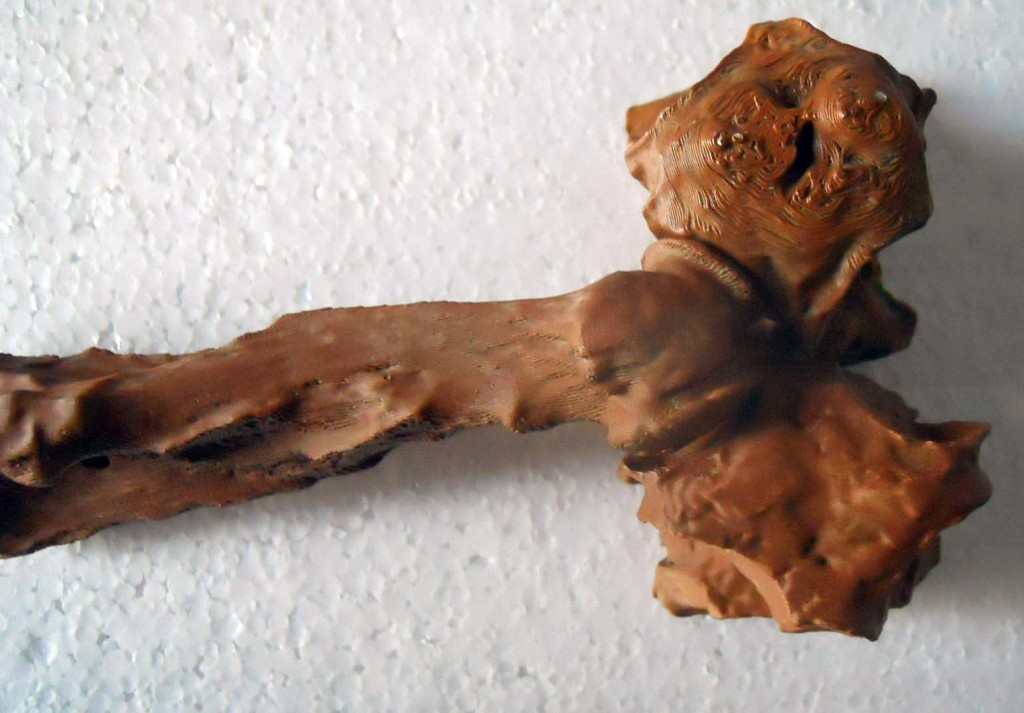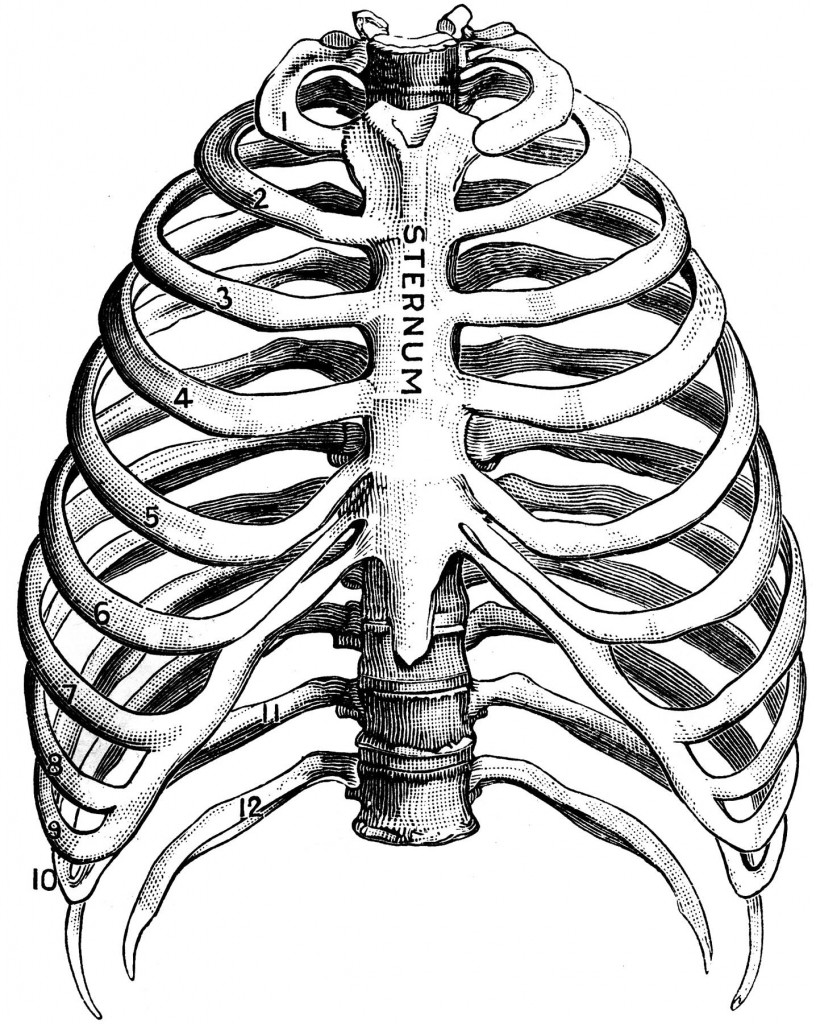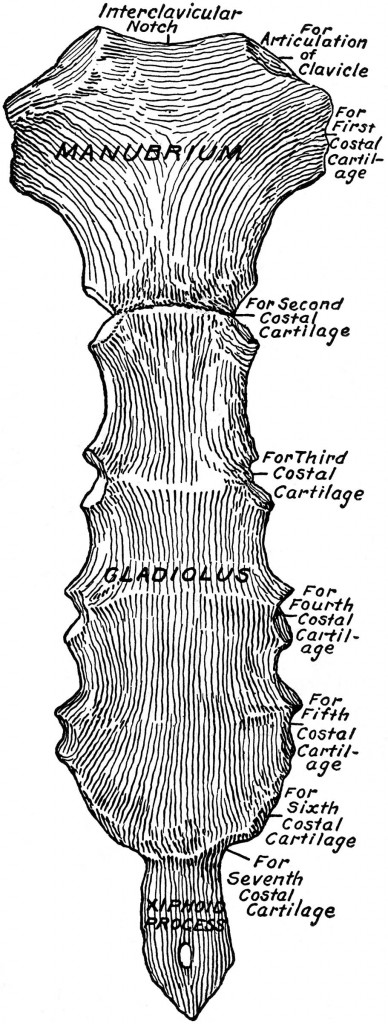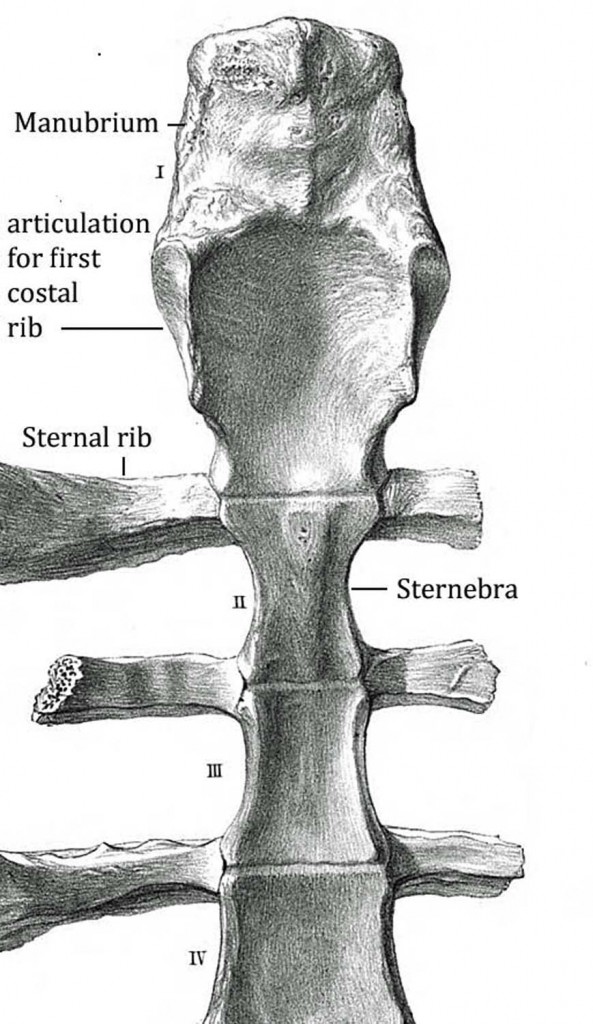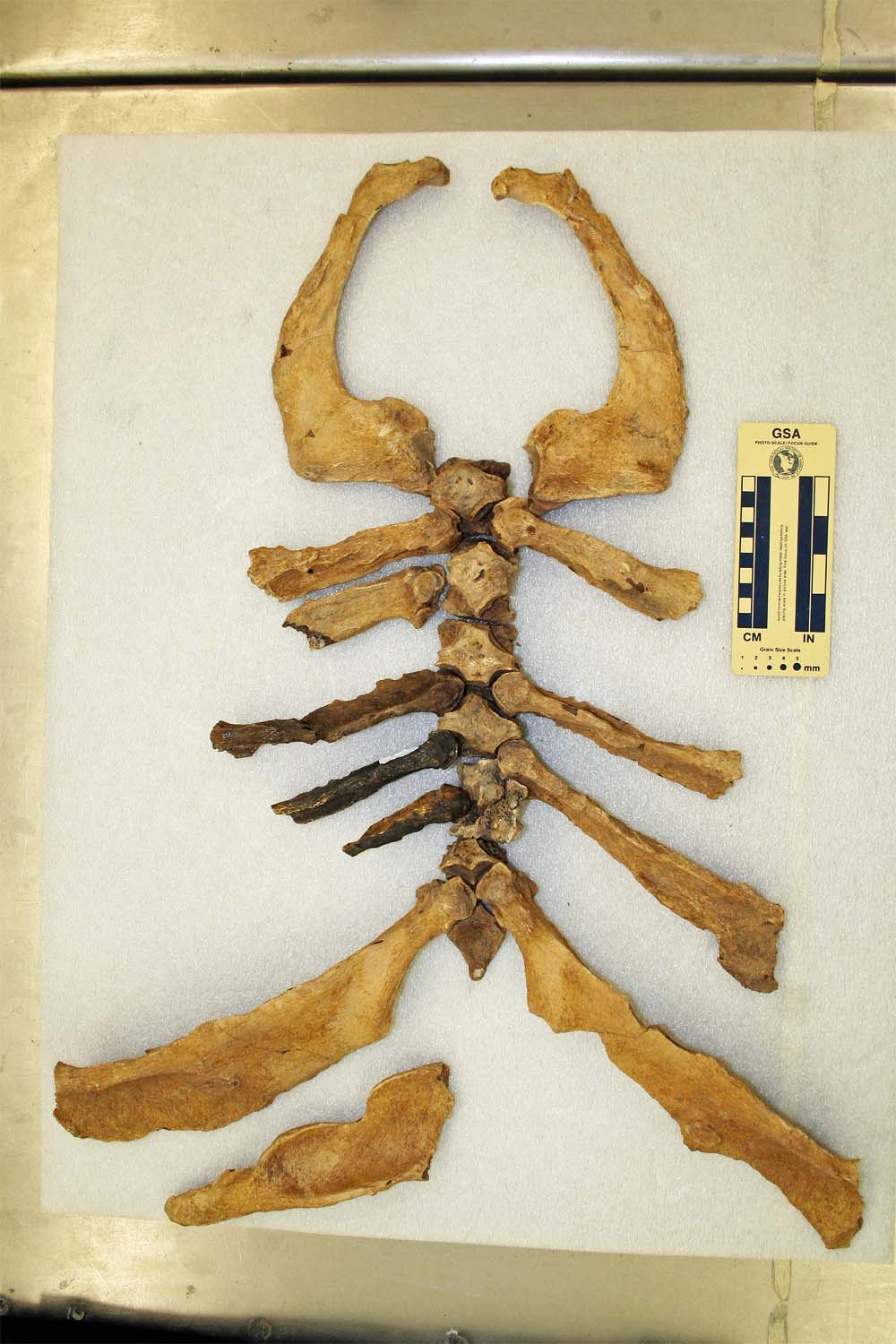Introduction to Walk Like a Sloth: lessons in ground sloth locomotion
 Getting Oriented
Getting Oriented
Megalonyx has a sternum or breast bone composed of a stack of eight (8) separate bones called sternebrae (singular is sternebra). The sternebrae connect to the ribs through eight (8) pairs of bones called sternal ribs that curve around the front of the chest and connect to the true ribs with a thin layer of cartilage. The triangle wide, flat, smooth back of the sternebrae is the “in” side or dorsal surface. Notice the protruding opposite side, called the ventral process, is heavily textured. As in all Megalonyx bones, this increases the surface area for anchoring the sloth’s powerful muscles, in this case, the pectorals.
Try stacking the sternebrae as shown in the picture below. Notice that each pair of sternebrae forms a of articulating joints or facets–two large facets on the top and bottom ends of adjacent sternebrae (a and a’ in the photo) plus one facet made up of two 1/2-facets or hemi-facets on the dorsal corners (b and b’). Now pick up a sternal rib and look for the triangle of corresponding articulating surfaces on its head. Fit the three bones together and see how the sternal ribs move in this complex system. Only one complete Megalonyx sternal system has ever been found, so determining the exact order of the sternebrae and sternal ribs is largely a matter of finding the best fit, until we have better evidence generic cialis online best price.
 Key points
Key points
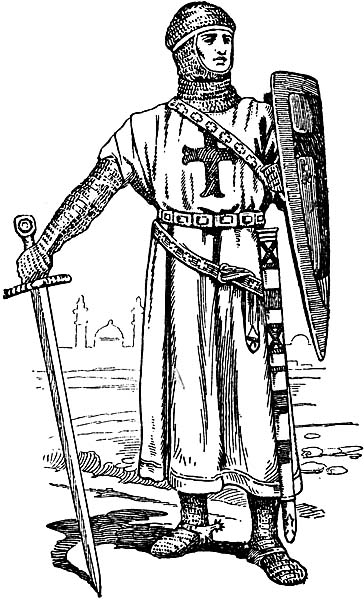
(Clipart courtesy FCIT)
#1 The sloth’s breast bone of articulating sternebrae and sternal ribs is unique to Xenarthrans (the sloths’ order, meaning “double jointed,” a reference to the extra articulations on their lumbar vertebrae.) Other animals, including humans, have breast “bones” of cartilage, that ossify (become solid bone) at adulthood (in our case about age 25) but they retain long cartilage connections to the ribs to stay flexible. Together the sternebrae and sternal ribs wrap the sloth’s entire chest and abdomen in a shield with the flexibility of cartilage but the strength of bone, like the flexible steel chain mail ancient knights wore.
#2 The set of sternal ribs we found is incomplete and their ends are broken off. In life they were longer and wider–flattening as you move around toward the true ribs, and growing even wider toward the bottom of the rib cage. Their role in protection and anchoring powerful arm muscles seems clear, however, sternal ribs may have had an additional function–they pushed the true (i.e. vertebral) ribs back and shifted the sloth’s center of gravity over its pelvis and feet. (see rib lesson) In other bipedal animals this is accomplished by widening the breast bone. (Slijper, 1942) Ground sloths evolved their own special bones to do it!
#3 If you are teaching older learners with a lot of experience with bones (e.g. medical professionals) try giving them a couple of sternebrae and asking them where they think the bones fit before you tell them anything else. They’ll go through a mental list of 206 human bones they memorized and be very surprised to come up blank.
 Additional information
Additional information
Sternum comes from the Greek sternos for “solid” or “hard,” probably because it sounds so when you thump it. To the ancient Romans the human sternum looked like a gladiator’s sword so they named the large top (superior section) the manubrium, “hilt” or “handle.” The next part, the gladiolus is Latin for “blade.” The bottom or xiphoid is Greek for “sword.” The three separate parts of the sternum are sometimes called sternebrae but they fuse completely together by about age 25 (though the different segments remain distinguishable). (Aiello and Dean, 1990) 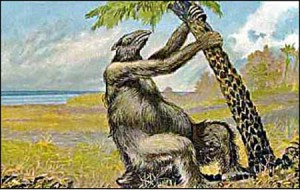
Owen (1842) saw the sternebrae and sternal ribs as evidence supporting his theory that sloths gathered their food by ripping trees out of the ground (see claw lesson). In his view the bony sternum was protection against falling tree branches and also anchored the massive muscles needed to accomplish the Herculean task.
The cartilaginous breast bones of other mammals occasionally ossify, i.e. the animals deposit bony material inside to firm them up, but separate sternal bones and articulating features are unique to this order of animals. (McDonald, 2003) The Xenarthrans were the earliest branch to separate from the placental mammals, and have had a very long time to evolve their own specialized features. A bony sternum is often called primitive, but it might just be different and as highly specialized as anything found in the so-called higher mammals. If the other mammals had evolved sternebrae (or teeth like sloths (see mandible lesson) we might view them with more respect.
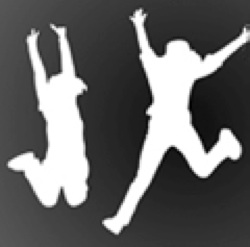 Things to do
Things to do
Breath like a sloth Put your hand on your chest and take a deep breath; now exhale.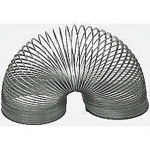 Can you feel your chest expand and contract as you breathe? We call this our rib cage but it acts a lot more like a slinky toy. Keep you hand on your chest and bend your upper torso from side to side. Can you feel your ribs shift around? That’s the benefit of having flexible cartilage (the same thing that makes your nose and ears flexible). Sloths achieve the same results with special bones and joints. Imagine how stiff you would be if your ribs were locked into place by unyielding bone.
Can you feel your chest expand and contract as you breathe? We call this our rib cage but it acts a lot more like a slinky toy. Keep you hand on your chest and bend your upper torso from side to side. Can you feel your ribs shift around? That’s the benefit of having flexible cartilage (the same thing that makes your nose and ears flexible). Sloths achieve the same results with special bones and joints. Imagine how stiff you would be if your ribs were locked into place by unyielding bone.
Laugh like a sloth: When quadrupeds run they have to take a breath with every stride. A chest full of air helps brace their bodies against the impact of their front legs on the ground. That’s also why you take a deep breath when you lift a heavy weight–it provides extra support. Walking bipedally frees the chest from the locomotion support-function and allows greater flexibility in breathing and vocalizations like calls, speech or even laughter. (Provine, 2012) Scientists call this the “walkie-talkie theory” of language evolution in humans. (ibid.) Standing erect, it’s possible sloths could call and laugh just like us.
Give your chest a good thump. It’s easy to see how the sternum got its name. Feel the bone at the top of your sternum, just under your Adam’s apple–that’s the top of the manubrium called the interclavicular notch or jugular notch. Follow the notch around the base of your neck and you’ll move to your clavicles or collar bones. More on those later (see the clavicle lesson). The sternum provides important stability for the verterbral column or back bone by anchoring the distal ends of the ribs. People who break their sternums (a common fracture in car accidents when the drivers hit the steering wheel) often go on to suffer serious back problems too because of the increased twisting and bending their backs go through before the fracture heals and their torsos are once more stabilized. (Watkins et al., 2005)
Make an Ice Age flood Finding small bones like the sternebrae mixed in with large bones like the femur at the fossil site is evidence the animals didn’t die and decompose elsewhere and have their bones entombed here by flood deposits. Flood waters would have sorted the bones by carrying the smaller and lighter ones further downstream. Scientists use room-sized pools with flowing water called stream tables to test how bones move in a flood. You can do the same thing outside on the sidewalk or playground with a hose and an assortment of large and small material (a handful of sand and different sized pebbles and twigs works well). Turn the hose on just enough to start moving the pile. Which items travel the furthest? Which travel the least? Increase the water flow. What changes?
Flex Your Muscles As with your sternum, the the sternebrae anchor the sloth’s 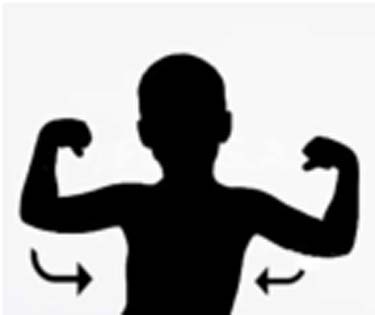 powerful pectoralis major muscles which adduct or pull in the sloth’s arm from the side. The sternal ribs serve to anchor the pectoralis minor muscles which insert on the coracoid of the scapula and help rotate the scapula down, adding power to the arm pull (more in the scapula lesson); important muscles for an animal ripping branches off of trees!
powerful pectoralis major muscles which adduct or pull in the sloth’s arm from the side. The sternal ribs serve to anchor the pectoralis minor muscles which insert on the coracoid of the scapula and help rotate the scapula down, adding power to the arm pull (more in the scapula lesson); important muscles for an animal ripping branches off of trees!
 Things to think about
Things to think about
If the sloth bones had been carried to the dig site by a flood would there be other evidence of the event? [If the sloths’ remains had been carried to the W. Tarkio site by a flood they would have been buried by everything else the powerful floodwaters would have carried including tree trunks, branches, mud, sand, rocks and even boulders. Instead we found the sloth bones buried in the top layer of a silt and clay deposit about four (4) feet thick. That indicates the water was moving very very slowly, otherwise the tiny particles would have been washed away. The thickness indicates these conditions persisted for a long time. No, the sloths had to walk here to die.]
Why are sloths are viewed with so little respect? When explorers first discovered two and three-toed tree sloths in the New World they marvelled (and sneered) at their slowness and named them for one of the so called deadly sins, “sloth,” i.e. indolence or laziness. Today we know the slow movements of tree sloths are just a clever adaptation to avoid detection by predators and nothing prevents them from making fast and even graceful movements when they feel the urge. Did ground sloths have to worry about any predators? Probably not, especially adults or juveniles under watchful eye and extended care of an adult, as the Tarkio discovery supports they had–but there is that wound in the adult’s tail to consider . . . . (see the caudal vertebrae lesson)
 Future research
Future research
Only one complete set of Megalonyx sternebrae and sternal ribs has ever been discovered (American Falls, ID) but the partial remains found elsewhere raise some intriguing possibilities. (McDonald, 1977) The Idaho sternum is assymmetrical with the sternal ribs originating higher (more anterior) on the right side than the left. In an Ohio specimen (Darke Co.), it’s the facets for the left ribs which are higher. (ibid.) 70% of humans show similar assymmetry in the connections of their ribs, with 57% shifted upward on the right side. Scientists have suggested this is linked to our being right-handed. (Paterson, 1904) Could this be the case with sloths too?
Scientists have recently discovered that many dinosaurs that used their tails as defensive weapons also had bony sternums. Solid chest bones helped to stabilize their bodies when they made the wide powerful swings with their tails. (Tschopp and Mateus, 2013) Some dinosaurs with large centers of mass in their rear ends (e.g. diplodocus) evolved bony sternums too, possibly to reduce the stress on their shoulders during locomotion; Titanosaurs on the other hand adopted sternums of cartilage when they evolved their extra-wide leg spacing. Wide stable legs may have made bony sternums unnecessary. (ibid.) There is still much to be learned but the part the sternum plays in stabilizing the torso but it’s clear it can play an important role in locomotion–two or four legged.
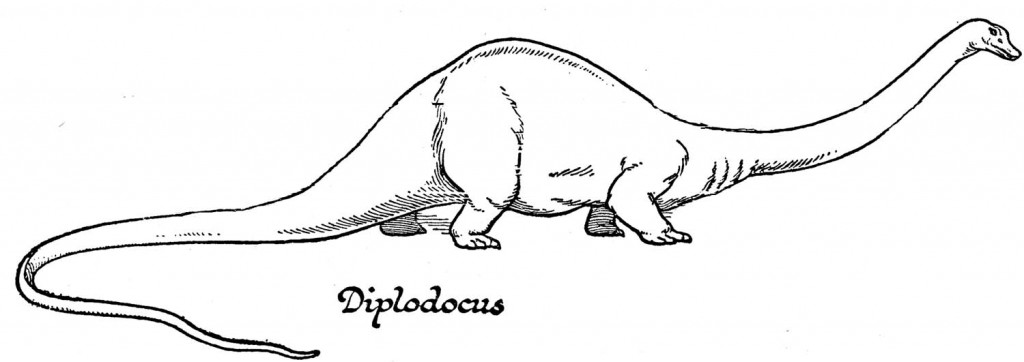
(Clipart courtesy FCIT)
Conclusion
The sternal system of articulating bones in ground sloths is unique in the animal kingdom and suggests an adaptation for special behavior. To early scientists bony sternebrae and sternal ribs offered sloths protection and extra anchoring points for large powerful chest muscles. However, modern dinosaur scientists point out that locomotion, and especially bipedal locomotion, demands this kind of skeletal modification. To learn which view is correct (or both) we’re going to have to look elsewhere in the skeleton.
TO LEARN MORE ABOUT OR TO BORROW THE UNIVERSITY OF IOWA MUSEUM OF NATURAL HISTORY GEO-2-GO DISCOVERY TRUNKS CALL OR CONTACT THE MUSEUM.
References
Aiello, L. and Dean, C. 1990. Introduction to Human Evolutionary Anatomy. Academic Press Limited. San Diego, CA.
Educational Technology Clearinghouse, Florida Center for Instructional Technology, College of Education, University of Southern Florida http://etc.usf.edu/clipart/
McDonald, H. G. 1977. Description of the osteology of the extinct gravigrade edentate Megalonyx with observations on its ontogeny, phylogeny and functional anatomy. Master’s Thesis. University of Florida.
McDonald, H. G. 2003. Xenarthran skeletal anatomy: primitive or derived? Senckenbergiana Biologica 83: 5-17.
Owen, R. 1842. Description of the Skeleton of an Extinct Giant Sloth, Mylodon robustus, Owen: with observations on the osteology, natural affinities, and probable habits of the Megatheroid quadrupeds in general. John Van Voorst, Publ. London.
Paterson, A.M. 1904. The Human Sternum: three lectures. Williams & Norgate, London. 144 pp.
Provine, R. R. 2012, Curious Behavior: Yawning, Laughing, Hiccupping, and Beyond. Harvard University Press. 246 pp.
Slijper, E. J. 1942. Biological-anatomical investigations on the bipedal gait and upright posture in mammals, with special reference to a little goat born without forelegs. Koninklijke Nederlandse Akademie van Wetenschappen. Afdeling Natuurkund 45: 288-295, 407-415.
Tschopp, E. and Mateus, O. 2013. Clavicles, interclavicles, gastralia, and sternal ribs in sauropod dinosaurs: new reports from Diplodocidae and their morphological, functional and evolutionary implications. Journal of Anatomy 222: 321-340.
Watkins, R. IV, Watkins,R. III, Williams, L., Ahlbrand, S., Garcia, R., Karamanian, A., Sharp, L., Vo, C. and Hedman, T. 2005. Stability provided by the sternum and rib cage in the thoracic spine. Spine, 30: 1283-1286.

